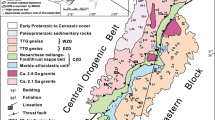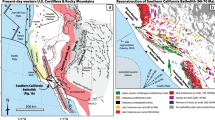Abstract
The subduction of oceanic plateaux, which contain extraordinarily thick basaltic crust and are the marine counterparts of continental flood-basalt provinces, is an important factor in many current models of plate motion1,2,3,4 and provides a potential mechanism for triggering plate reorganization5. To evaluate such models, it is essential to decipher the history of the collision between the largest and thickest of the world’s oceanic plateaux, the Ontong Java plateau, and the Australian plate, but this has been hindered by poor constraints for the arrival of the plateau at the Melanesian trench. Here we present 40Ar–39Ar geochronological data on hotspot volcanoes in eastern Australian that reveal a strong link between collision of the Greenland-sized Ontong Java plateau with the Melanesian arc and motion of the Australian plate. The new ages define a short-lived period of reduced northward plate motion between 26 and 23 Myr ago, coincident with an eastward offset in the contemporaneous tracks of seamount chains in the Tasman Sea east of Australia. These features record a brief westward deflection of the Australian plate as the plateau entered and choked the Melanesian trench 26 Myr ago. From 23 Myr ago, Australia returned to a rapid northerly trajectory at roughly the same time that southwest-directed subduction began along the Trobriand trough6. The timing and brevity of this collisional event correlate well with offsets in hotspot seamount tracks on the Pacific plate, including the archetypal Hawaiian chain7, and thus provide strong evidence that immense oceanic plateaux, like the Ontong Java, can contribute to initiating rapid change in plate boundaries and motions on a global scale.
This is a preview of subscription content, access via your institution
Access options
Subscribe to this journal
Receive 51 print issues and online access
$199.00 per year
only $3.90 per issue
Buy this article
- Purchase on Springer Link
- Instant access to full article PDF
Prices may be subject to local taxes which are calculated during checkout



Similar content being viewed by others
References
Wessel, P. & Kroenke, L. W. Ontong Java Plateau and late Neogene changes in Pacific plate motion. J. Geophys. Res. 105, 28255–28277 (2000)
Hall, R. Cenozoic geological and plate tectonic evolution of SE Asia and the SW Pacific: Computer-based reconstructions, model and animations. J. Asian Earth Sci. 20, 353–431 (2002)
Gaina, C. & Müller, D. Cenozoic tectonic and depth/age evolution of the Indonesian gateway and associated back-arc basins. Earth Sci. Rev. 83, 177–203 (2007)
Wessel, P. & Kroenke, L. W. Reconciling late Neogene Pacific absolute and relative plate motion changes. Geochem. Geophys. Geosyst. 8 doi: 10.1029/2007GC001636 (2007)
Cloos, M. Lithospheric buoyancy and collisional orogenesis: Subduction of oceanic plateaus, continental margins, island arcs, spreading ridges, and seamounts. Geol. Soc. Am. Bull. 105, 715–737 (1993)
Quarles van Ufford, A. & Cloos, M. Cenozoic tectonics of New Guinea. Am. Assoc. Petrol. Geol. Bull. 89, 119–140 (2005)
Kroenke, L. W., Wessel, P. & Sterling, A. in Origin and Evolution of the Ontong Java Plateau (eds Fitton, J. G., Mahoney, J. J., Wallace, P. J. & Saunders, A. D.) Geol. Soc. London Spec. Publ. 229, 9–20 (Geol. Soc. Publishing House, Bath, 2004)
Neal, C. R., Mahoney, J. J., Kroenke, L. W., Duncan, R. A. & Petterson, M. G. in Large Igneous Provinces: Continental, Oceanic, and Planetary Flood Volcanism (eds Mahoney, J.J. & Coffin, M. F.) Am. Geophys. Union Geophys. Monogr. 100, 183–216 (1997)
Coffin, M. F. & Eldholm, O. Scratching the surface: estimating dimensions of large igneous provinces. Geology 21, 515–518 (1993)
Sharp, W. D. & Clague, D. A. 50-Ma initiation of Hawaiian–Emperor bend records major change in Pacific Plate motion. Science 313, 1281–1284 (2006)
Petterson, M. G. et al. Structure and deformation of north and central Malaita, Solomon Islands: Tectonic implications for the Ontong Java Plateau–Solomon arc collision, and for the fate of oceanic plateaus. Tectonophysics 283, 1–33 (1997)
Cooper, P. A. & Taylor, B. Polarity reversal in the Solomon Islands arc. Nature 314, 428–430 (1985)
Mann, P. & Taira, A. Global tectonic significance of the Solomon Islands and Ontong Java Plateau convergent zone. Tectonophysics 389, 137–190 (2004)
Morgan, W. J. Convection plumes in the lower mantle. Nature 230, 42–43 (1971)
Clouard, V. & Bonneville, A. How many Pacific hotspots are fed by deep-mantle plumes? Geology 29, 695–698 (2001)
Tarduno, J. A. et al. The Emperor seamounts: Southward motion of the Hawaiian hotspot plume in Earth's mantle. Science 301, 1064–1069 (2003)
Foulger, G. R. & Natland, J. H. Is ‘hotspot’ volcanism a consequence of plate tectonics? Science 300, 921–922 (2003)
DePaolo, D. J. & Manga, M. Deep origin of hotspots: The mantle plume model. Science 300, 920–921 (2003)
Courtillot, V., Davaille, A., Besse, J. & Stock, J. Three distinct types of hotspots in the Earth’s mantle. Earth Planet. Sci. Lett. 205, 295–308 (2003)
Montelli, R. et al. Finite-frequency tomography reveals a variety of plumes in the mantle. Science 303, 338–343 (2004)
O'Neill, C., Müller, R. D. & Steinberger, B. On the uncertainties in hot spot reconstructions and the significance of moving hot spot reference frames. Geochem. Geophys. Geosyst. 6, 10.1029/2004GC000784 (2005)
McDougall, I. & Duncan, R. A. Age progressive volcanism in the Tasmantid seamounts. Earth Planet. Sci. Lett. 89, 207–220 (1988)
Duncan, R. A. & McDougall, I. in Intraplate Volcanism in Eastern Australia and New Zealand (ed. Johnson, R. W.) 43–53 (Cambridge Univ. Press, 1989)
Koppers, A. A. P., Duncan, R. A. & Steinberger, B. Implications of a nonlinear 40Ar/39Ar age progression along the Louisville seamount trail for models of fixed and moving hot spots. Geochem. Geophys. Geosyst. 5 doi: 10.1029/2003GC000671 (2004)
Cohen, B. E., Vasconcelos, P. M. & Knesel, K. M. 40Ar/39Ar constraints on the timing of Oligocene intraplate volcanism in southeast Queensland. Aust. J. Earth Sci. 54, 105–125 (2007)
Ashley, P. M., Duncan, R. A. & Feebrey, C. A. Ebor Volcano and Crescent Complex, northeastern New South Wales: Age and geological development. Aust. J. Earth Sci. 42, 471–480 (1995)
Wellman, P. Palaeomagnetism of two Mid-Tertiary basaltic volcanoes in Queensland Australia. Proc. R. Soc. Qld 86, 147–153 (1975)
McElhinny, M. W., Embleton, B. J. J. & Wellman, P. A synthesis of Australian Cenozoic palaeomagnetic results. Geophys. J. R. Astr. Soc. 36, 141–151 (1974)
Müller, R. D., Royer, J.-Y. & Lawver, L. A. Revised plate motions relative to the hotspots from combined Atlantic and Indian Ocean hotspot tracks. Geology 21, 275–278 (1993)
Ewart, A., Chappell, B. W. & Le Maitre, R. W. Aspects of the mineralogy and chemistry of the intermediate-silicic Cainozoic volcanic rocks of eastern Australia. Part 1: Introduction and geochemistry. Aust. J. Earth Sci. 32, 359–382 (1985)
Renne, P. R. et al. Intercalibration of standards, absolute ages and uncertainties in 40Ar/39Ar dating. Chem. Geol. 145, 117–152 (1998)
Vasconcelos, P. M., Onoe, A. T., Kawashita, K., Soares, A. J. & Teixeira, W. 40Ar/39Ar geochronology at the Instituto de Geociências, USP: Instrumentation, analytical procedures, and calibration. Ann. Brazil. Acad. Sci. 74, 297–342 (2002)
Steiger, R. H. & Jäger, E. Subcommission on geochronology: Convention on the use of decay constants in geo- and cosmochemistry. Earth Planet. Sci. Lett. 36, 359–362 (1977)
Vasconcelos, P. M. K–Ar and 40Ar/39Ar geochronology of weathering processes. Annu. Rev. Earth Planet. Sci. 27, 183–229 (1999)
Nier, A. O. A redetermination of the relative abundances of the isotopes of carbon, nitrogen, argon and potassium. Phys. Rev. 77, 789–793 (1950)
McDougall, I. & Harrison, T. M. Geochronology and Thermochronology by the 40Ar/39Ar Method. (Oxford Univ. Press, New York, 1999)
Kelley, S. Excess argon in K–Ar and Ar–Ar geochronology. Chem. Geol. 188, 1–22 (2002)
Ludwig, K. R. Isoplot Version 3.00: A Geochronological Toolkit for Microsoft Excel. Berkeley Geochronology Center Spec. Publ. 4, (Berkeley Geochronology Center, 2003)
Tregoning, P. Plate kinematics in the western Pacific derived from geodetic observations. J. Geophys. Res. 107, ECV 7-1–8 (2002)
Petkovic, P. & Buchanan, C. Australian Bathymetry and Topography Grid [Digital Dataset] (Geoscience Australia, Canberra, 2002)
Acknowledgements
We thank M. Cloos, A. Ewart, M. Gasparon, A. Koppers, G. Rosenbaum and W. Sharp for comments; the Queensland and New South Wales Parks and Wildlife Services and various landowners for permission to undertake fieldwork on their properties; and A. Ewart and F. L. Sutherland for providing samples. Construction of the University of Queensland Argon Geochronology in Earth Sciences laboratory (UQ-AGES) was partially funded by the ARC; this project was funded through UQ-AGES contract research and an Australian Postgraduate award to B.E.C.
Author information
Authors and Affiliations
Corresponding authors
Supplementary information
The file contains Supplementary Figures 1-7 with Legends and Supplementary Tables 1-3
The file contains 40Ar/39Ar incremental-heating spectra, total-fusion results, and isochron diagrams for the Main Range, Tweed, Belmore, Ebor and Comboyne central volcanoes in eastern Australia in Supplementary Figures 1-5. Supplementary Figure 6 shows 40Ar/39Ar incremental-heating results for the international standard GA1550. Supplementary Figure 7 shows half-spreading rates for Australia and Antarctica for the last ~40 million years, calculated from seafloor-spreading magnetic anomalies, which provide independent evidence for a reduction in Australian plate velocity at 26 Ma. The caption to Supplementary Figure 7 also contains a brief discussion of paleomagnetic evidence, from both the marine and continental records, in support of the identified plate-motion change between 26-23Ma. The file also contains Supplementary Tables 1 and 2 that provide sample locality information and a summary of incremental-heating and total-fusion 40Ar/39Ar results, respectively. Supplementary Table 3 provides the full 40Ar/39Ar analytical dataset, including J factors and discrimination values. (PDF 4736 kb)
Rights and permissions
About this article
Cite this article
Knesel, K., Cohen, B., Vasconcelos, P. et al. Rapid change in drift of the Australian plate records collision with Ontong Java plateau. Nature 454, 754–757 (2008). https://doi.org/10.1038/nature07138
Received:
Accepted:
Issue Date:
DOI: https://doi.org/10.1038/nature07138
This article is cited by
-
Increasing complexity in magmatic architecture of volcanoes along a waning hotspot
Nature Geoscience (2023)
-
Kimberlite eruptions driven by slab flux and subduction angle
Scientific Reports (2023)
-
Neogene subduction initiation models in the western Pacific and analysis of subduction zone parameters
Science China Earth Sciences (2023)
-
Petrological and geochemical constraints of mantle peridotites on the magma-starved Yap Arc formed by ultra-slow subduction
Contributions to Mineralogy and Petrology (2023)
-
Cyclical one-way continental rupture-drift in the Tethyan evolution: Subduction-driven plate tectonics
Science China Earth Sciences (2019)
Comments
By submitting a comment you agree to abide by our Terms and Community Guidelines. If you find something abusive or that does not comply with our terms or guidelines please flag it as inappropriate.



